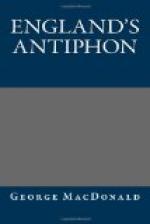Before making further remark on George Herbert, let me present one of his poems in which the oddity of the visual fancy is only equalled by the beauty of the result.
THE PULLEY.
When God at first made man,
Having a glass of blessing standing by,
“Let us,” said he, “pour
on him all we can:
Let the world’s riches, which dispersed
lie,
Contract into
a span.”
So strength first
made a way;
Then beauty flowed; then wisdom, honour,
pleasure.
When almost all was out, God made a stay,
Perceiving that, alone of all his treasure,
Rest in
the bottom lay.
“For if
I should,” said he,
“Bestow this jewel also on my creature,
He would adore my gifts instead of me,
And rest in nature, not the God of nature:
So both should
losers be.
“Yet let
him keep the rest—
But keep them with repining restlessness:
Let him be rich and weary, that, at least,
If goodness lead him not, yet weariness
May toss him to
my breast.”
Is it not the story of the world written with the point of a diamond?
There can hardly be a doubt that his tendency to unnatural forms was encouraged by the increase of respect to symbol and ceremony shown at this period by some of the external powers of the church—Bishop Laud in particular. Had all, however, who delight in symbols, a power, like George Herbert’s, of setting even within the horn-lanterns of the more arbitrary of them, such a light of poetry and devotion that their dull sides vanish in its piercing shine, and we forget the symbol utterly in the truth which it cannot obscure, then indeed our part would be to take and be thankful. But there never has been even a living true symbol which the dulness of those who will see the truth only in the symbol has not degraded into the very cockatrice-egg of sectarianism. The symbol is by such always more or less idolized, and the light within more or less patronized. If the truth, for the sake of which all symbols exist, were indeed the delight of those who claim it, the sectarianism of the church would vanish. But men on all sides call that the truth which is but its form or outward sign—material or verbal, true or arbitrary, it matters not which—and hence come strifes and divisions.
Although George Herbert, however, could thus illumine all with his divine inspiration, we cannot help wondering whether, if he had betaken himself yet more to vital and less to half artificial symbols, the change would not have been a breaking of the pitcher and an outshining of the lamp. For a symbol may remind us of the truth, and at the same time obscure it—present it, and dull its effect. It is the temple of nature and not the temple of the church, the things made by the hands of God and not the things made by the hands of man, that afford the truest symbols of truth.




